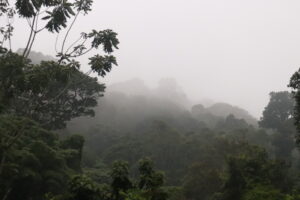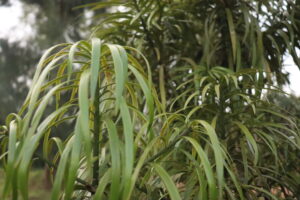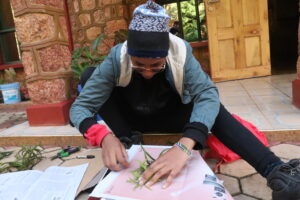Did you know that hidden within the Western Usambara Mountains in Tanzania is a rare and extraordinary tree species, Podocarpus henkelii, commonly known as Henkelii’s Yellowwood?
This remarkable tree, locally known as Mpodo, Mse or Mse kichungwa, is the star of today’s story.
This is a unique species with specific habitat requirements, despite its closely related species being widely distributed in the Usambaras. It faces a web of challenges from seed to survival. Its seeds, vulnerable to fungal infections and eagerly consumed by birds, often struggle to establish. With limited habitat available and low chances of natural regeneration, population growth remains constrained. Add to that the demand for its valuable timber, and the pressure from other human-induced disturbances intensifies the struggle for this species, making it rare in the wild.
My name is Luciana Piniely, an EDGE Fellow in the 2023 EDGE Africa cohort and a passionate young plant scientist. My work is dedicated to protecting rare and threatened plant species. With a deep love for botany, my career journey started by studying the plants of Tanzania, seeking ways to ensure their survival. This journey has led me to the unique, magnificent Podocarpus henkelii.
Join me as I take you on a journey through the efforts to save this unique species. Let’s explore its fascinating world and what it takes to protect it, from hands-on fieldwork to community workshops.

About the project
Our project aims to assess the conservation status of Podocarpus henkelii in Tanga, Tanzania. As the starting point for the conservation of this species, nationally, the project aims to begin with the Western Usambara Mountains, the home of giant trees for centuries. It focuses on the following:
- Confirming the presence of P. henkelii in the previously documented sites in Lushoto, Tanzania.
- Estimate the population density of the species.
- Evaluate the economic impact and threats to the species.
- Raise public awareness of the species.
Why Podocarpus henkelii?
Podocarpus henkelii is an endangered plant species with a declining population globally despite being found in four countries: South Africa, Tanzania, Malawi, and Zimbabwe. It thrives in mountainous forests, in moisture-rich, rocky, and steep-slope habitats surrounded by towering, centuries-old trees. This species is susceptible to ecological and anthropogenic stresses, making its survival particularly challenging. For many years, the species has been utilized for timber and firewood across its range, as well as for medicinal purposes in South Africa.
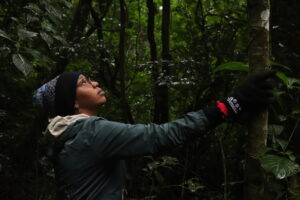

Habitat of P.henkelii ( Magamba Nature Forest Reserve)
The Journey
Our journey started by searching for the species across all the documented sites in the Western Usambara Mountains, but challenges are never far from a wild search.
Our first challenge was identifying this species, not as easy as it sounds. From a distance, its long drooping leaves distinguish it from its closely related species, but up close, the leaves are very similar. It’s hard to tell since its close relative, especially P. latifolius, has long leaves that resemble those of P.henkelii. This makes the species hard to identify in the understory if the canopy is not seen. It was also difficult to distinguish the species by examining the bark since its smooth texture and peeling character is also expressed by its close relative, P.latifolius. With the assistance of Dr. Matilda Brown, a Conservation Science Analyst at Royal Botanic Gardens, Kew, we verified the identification of Podocarpus henkelii in the field and collected herbarium specimens. These samples were carefully prepared and preserved at the National Herbarium of Tanzania (NHT) to serve as a permanent record of the species’ presence and characteristics in the study area. These specimens are recent collections, as the last specimen from this locality was collected in 1976, with the most recent collection made in 2008 from a different site in the Iringa region. This is very important because it documents the species’ locality and its status.

Matilda Brown (Podocarpus specialist from Kew) and I on the struggle of identifying Podocarpus species
Dropping leaves of Podocarpus henkelii
Preparing herbarium specimen of Podocarpus henkelii
The reality: Threats to P. henkelii
At this point, the situation was bittersweet, as confirming the presence of the species was encouraging, but it was also concerning to note that in some previously documented locations, the species could no longer be found because human settlements and plantations had replaced these areas. Forest fire scars were seen in places where P. henkelii was present, indicating a threat to even the few remaining individuals in these habitats. The remaining individuals of P. henkelii are located within the Magamba Nature Forest Reserve and Shagayu Forest Reserve, which are protected by the Tanzania Forestry Services Agency (TFS).
Population of P. henkelii in the identified sites
Through a thorough survey in the selected sites at Magamba and Shagayu Forest Reserve, we identified 70 adult individuals of P. henkelii. The population of this species is very low due to its specific habitat requirements. The species was observed in specific forest patches with healthy vegetation, a closed canopy, and dense growth, with no disturbance whatsoever. The species were only found in intact and undisturbed habitats, and despite this, the number of species in those habitats remains low.
This is good news for conservation efforts, but here’s a question: Can we ensure the protection of this species without involving the community?
Spoiler alert: We can’t.
Local Community Involvement
The phrase ‘every successful conservation story begins with involving the local community’ was no exception for our story; we involved community leaders, the local environmental committee, and the Tanzania Forestry Services Agency, which manages the forests, to spread the word about the status and importance of Mpodo.
Through workshops, the project successfully reached approximately 1,250 people, distributing 1,200 flyers to spread awareness among primary and secondary school students, as well as local conservation champions.

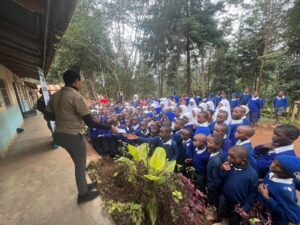

Reaching the Public
The efforts did not stop locally. To ensure that the public stays informed about what is happening, we presented our project on the Tanzania Plant Health and Pesticides Authority’s media (TPHPA HABARI TV). Click the link https://youtu.be/6vz1wmYn-mU?si=luN0cOp5lrZDL1zm.
The Way Forward
Conservation is a shared responsibility and a process that moves one step at a time. While the project has achieved incredible milestones, the journey is far from over. There are still many previously documented areas in the Uluguru and Udzungwa Mountains that we haven’t had the chance to explore. Exploring these places in the future will help us better understand where the species grows and how to protect it across Tanzania. Looking ahead, we plan to propose that P. henkelii be added to the list of officially protected plants in the country. We also hope to grow more seedlings and work more closely with local communities so that conservation becomes a shared effort.
This is just the beginning of a bigger journey. Stay tuned for more blogs from me with updates, stories, and next steps as we move forward together to protect this special tree.
“FROM SEED TO CANOPY, EVERY ACTION MATTERS”
Luciana Naftal Piniely
2023 EDGE Fellow
